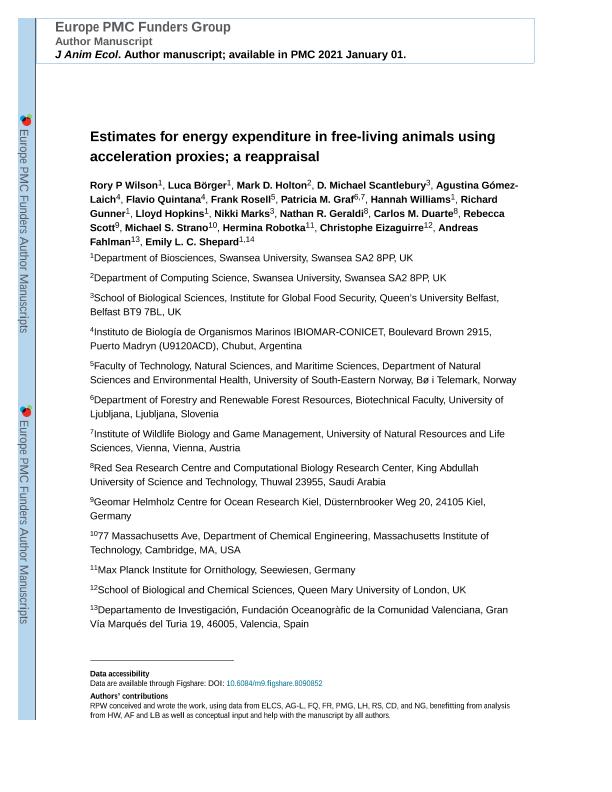Artículo
Estimates for energy expenditure in free-living animals using acceleration proxies: A reappraisal
Wilson, Rory P.; Börger, Luca; Holton, Mark; Scantlebury, D. Michael; Gómez Laich, Agustina Marta ; Quintana, Flavio Roberto
; Quintana, Flavio Roberto ; Rosell, Frank; Graf, Patricia M.; Williams, Hannah; Gunner, Richard; Hopkins, Lloyd; Marks, Nikki; Geraldi, Nathan R.; Duarte, Carlos M.; Scott, Rebecca; Strano, Michael S.; Robotka, Hermina; Eizaguirre, Christophe; Fahlman, Andreas; Shepard, Emily L. C.
; Rosell, Frank; Graf, Patricia M.; Williams, Hannah; Gunner, Richard; Hopkins, Lloyd; Marks, Nikki; Geraldi, Nathan R.; Duarte, Carlos M.; Scott, Rebecca; Strano, Michael S.; Robotka, Hermina; Eizaguirre, Christophe; Fahlman, Andreas; Shepard, Emily L. C.
 ; Quintana, Flavio Roberto
; Quintana, Flavio Roberto ; Rosell, Frank; Graf, Patricia M.; Williams, Hannah; Gunner, Richard; Hopkins, Lloyd; Marks, Nikki; Geraldi, Nathan R.; Duarte, Carlos M.; Scott, Rebecca; Strano, Michael S.; Robotka, Hermina; Eizaguirre, Christophe; Fahlman, Andreas; Shepard, Emily L. C.
; Rosell, Frank; Graf, Patricia M.; Williams, Hannah; Gunner, Richard; Hopkins, Lloyd; Marks, Nikki; Geraldi, Nathan R.; Duarte, Carlos M.; Scott, Rebecca; Strano, Michael S.; Robotka, Hermina; Eizaguirre, Christophe; Fahlman, Andreas; Shepard, Emily L. C.
Fecha de publicación:
06/2019
Editorial:
Wiley Blackwell Publishing, Inc
Revista:
Journal Of Animal Ecology
ISSN:
0021-8790
e-ISSN:
1365-2656
Idioma:
Inglés
Tipo de recurso:
Artículo publicado
Clasificación temática:
Resumen
It is fundamentally important for many animal ecologists to quantify the costs of animal activities, although it is not straightforward to do so. The recording of triaxial acceleration by animal-attached devices has been proposed as a way forward for this, with the specific suggestion that dynamic body acceleration (DBA) be used as a proxy for movement-based power. Dynamic body acceleration has now been validated frequently, both in the laboratory and in the field, although the literature still shows that some aspects of DBA theory and practice are misunderstood. Here, we examine the theory behind DBA and employ modelling approaches to assess factors that affect the link between DBA and energy expenditure, from the deployment of the tag, through to the calibration of DBA with energy use in laboratory and field settings. Using data from a range of species and movement modes, we illustrate that vectorial and additive DBA metrics are proportional to each other. Either can be used as a proxy for energy and summed to estimate total energy expended over a given period, or divided by time to give a proxy for movement-related metabolic power. Nonetheless, we highlight how the ability of DBA to predict metabolic rate declines as the contribution of non-movement-related factors, such as heat production, increases. Overall, DBA seems to be a substantive proxy for movement-based power but consideration of other movement-related metrics, such as the static body acceleration and the rate of change of body pitch and roll, may enable researchers to refine movement-based metabolic costs, particularly in animals where movement is not characterized by marked changes in body acceleration.
Archivos asociados
Licencia
Identificadores
Colecciones
Articulos(IBIOMAR)
Articulos de INSTITUTO DE BIOLOGIA DE ORGANISMOS MARINOS
Articulos de INSTITUTO DE BIOLOGIA DE ORGANISMOS MARINOS
Citación
Wilson, Rory P.; Börger, Luca; Holton, Mark; Scantlebury, D. Michael; Gómez Laich, Agustina Marta; et al.; Estimates for energy expenditure in free-living animals using acceleration proxies: A reappraisal; Wiley Blackwell Publishing, Inc; Journal Of Animal Ecology; 89; 1; 6-2019; 161-172
Compartir
Altmétricas



